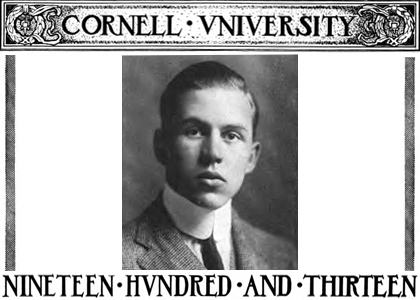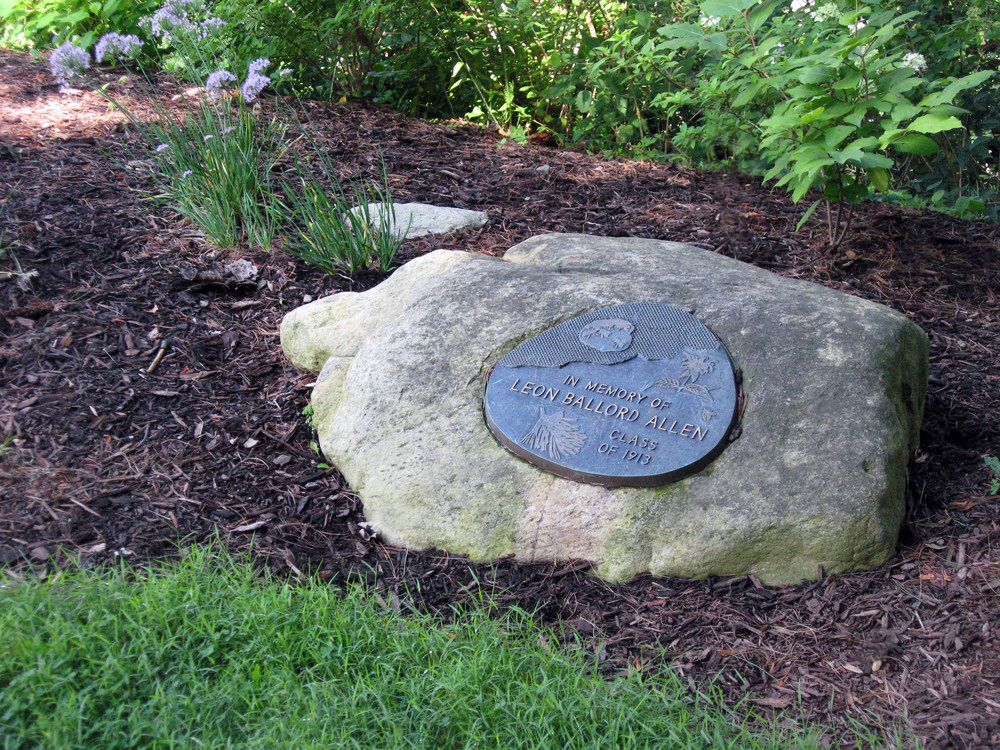When walking along a shady path bordering Forest Home Drive in the F.R. Newman Arboretum, a sign recessed in the vegetation and with the simple words “memorial area” signals entry into the heart of the Floriculture War Memorial. This leafy area honors the 14 students in what was then the Floriculture Department who lost their lives in the two world wars.
The Floriculture War Memorial is one of several sites at Cornell Botanic Gardens that honor members of the Cornell community, who served in the U.S Armed Forces, and it is among the many enduring acknowledgements of veterans across the Cornell campus.
Many of Cornell’s sites honor those who served in World War I and World War II—not surprising, considering that the university dispatched thousands of its own to serve in these conflicts. During World War I, Cornell provided a total of 4,598 commissioned officers to the war effort, more than any other institution, including West Point.
The Cornell Veteran’s Colleague Network Group is doing the ongoing work of identifying and documenting sites at Cornell that honor military veterans and making this information available on its Cornell University Veterans Memorials website. The group also organizes running and walking tours of military-related sites at Cornell.
Here are some of the places at Cornell Botanic Gardens that recognize the service of veterans across generations:
Sackett Bridge
Located in Cornell Botanic Gardens’ Beebe Lake natural area, Sackett Bridge is traversed by hundreds of people each day, for commuting and recreation. The bridge and surrounding stonework recognize Colonel Henry Woodward Sackett, Class of 1875, a native of Enfield, who was a non-commissioned officer in Squadron A, New York’s noted cavalry organization. In 1896, he was appointed Aide-de-camp for the New York State Governor. Sackett was a generous donor to Cornell, leaving $250,000 (the 2020 equivalent of $3.8 million) to the university for beautification of the Cascadilla and Fall Creek gorges. In his will, he states his wish to make the “intimate enjoyment of these great objects of beauty, more accessible to all.”
The arched stone bridge has been the site of countless marriage proposals, such as one in 1961, when Bob Everson ’61 popped the question to Barbara Ballweg Everson ’61. The couple was married in Ithaca in June 1961, just hours after they graduated and Bob was commissioned as a U.S. Navy officer.

Leon Ballord Allen Trail
One of the many hidden gems of the F.R. Newman Arboretum honors Leon Ballord Allen, ’13, who was a participant in World War I, serving as a 1st Lieutenant in the Army from 1917 to 1918 at Camp Taylor in Louisville, Kentucky.
“I have a feeling that the class of 1913 was unique,” says Carol Dorsey, Allen’s stepdaughter. “When he and his friends would go to a movie downtown, if they did not like the show, they would literally take their seats with them “up the hill.” They paid for a seat, and thus were entitled to it!”

Shenanigans aside, Allen experienced and overcame great loss in his life, with the deaths of all three of his children before the age of 10 and two wives.
“Yet he was kind and wise, working until the very end, charitable to church and the Young Men’s Christian Association, and always “walking with his God,” says Dorsey, who with her mother gave the Allen Trail in his memory in 1973.
The Leon Ballord Allen Trail is a shady, landscaped path, leading from the eastern end of the Treman Woodland Walk to the northern end of Grossman Pond. It offers dramatic views of the Zucker Shrub Collection below. On the east end of the trail, a set of three benches honor Allen. They are nestled in a shady space among an arrangement of small trees and shrubs, including pekin lilac (Syringa reticulata), old fashioned weigela (Weigela florida ‘Kolsunn’), and Jerusalem sage (Phlomis russeliana).

Palmer-Kinne Dogwood Collection
The Palmer-Kinne Dogwood Collection dots the arboretum between the Sculpture Garden and Native Maple Slope. It honors Birge Warner Kinne, ’16, who served as 2nd Lieutenant in the 340th Field Artillery. He saw action in France at Ypres-Lys Saint Mihiel.
“The Kinne Family was from Ovid, so Cornell was the “local” school,” writes Holly Isdale ’86, Kinne’s granddaughter. “Lore has it that my grandfather talked his way into Cornell by diverting some peaches he was sent to deliver to market and taking them to the dean of the Agriculture School instead.”
Showy flowers and fruit, rich fall colors, and ornamental bark give the Palmer-Kinne Dogwood Collection interest in all seasons. It features shrubby dogwoods (Cornus spp.) that are selected for their multi-season interest, Kousa dogwoods for spring flowers and large fall fruit, and mature cornelian cherries for early spring flowers, attractive bark, and abundant fruit.
Floriculture War Memorial
“We dedicated this site and the surrounding woodland to the memory of those students in the Floriculture Department who died in World War I and World War II,” reads the plaque on a bolder in this leafy memorial area. The memorial boulder is found along the trail, which runs east-to-west along the F.R. Newman Arboretum’s edge across from Fall Creek.
A curvilinear stone bench, built in 2003 in memory of Karl Goldsmith ’47, provides a place to enjoy the sounds of the creek and to contemplate the monument. Goldsmith was a veteran of World War II, serving in the U.S. Army in Europe in the military police and in military intelligence.
The short, visually rich walk along the Floriculture War Memorial Trail features mature beeches and hemlocks shading ferns, astilbes, blue cohosh, and several species of sedge. The real stars of the streamside plantings are the immense western skunk cabbages (Lysichiton americanus), with soft green leaves three feet long and bright yellow hooded flowers that appear much later than those of our native eastern skunk cabbage, and are far more eye-catching.

Southeast Overlook
Sited to take advantage of the spectacular view of the lower arboretum, the Southeast Overlook, includes three benches set in a curved stone wall, atop a paving of bluestone. Like Sackett Bridge, the overlook was commissioned by a special gift from a military veteran—the late Jay Hyman ’55, DVM ’57. Hyman enlisted in the Air Force after completing his veterinary degree, and served a tour of duty in South Korea.
Hyman, a lover of the arts, influenced the design of the stone terrace and sitting area tucked into the hillside at the southeast rim of the arboretum bowl. It is a memorial to nine Cornell friends, who had passed away. A specimen of white oak (Quercus alba) planted on the west side forms a canopy over the terrace, providing shade in the late afternoon and enhancing the overlook’s private atmosphere.
Shannon Dortch is associate director of communications and marketing for Cornell Botanic Gardens